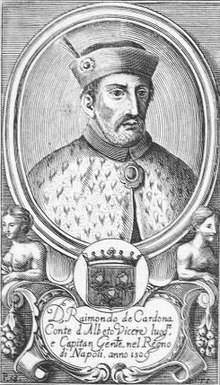Ramon Folch de Cardona
Ramón Folch de Cardona-Anglesola (* 1467 in Bellpuig , Province of Lleida , † 1522 in Naples ) from the Catalan noble house Folch de Cardona was Count of Albento , 11th Baron of Bellpuig, and since December 12th 1502 1st Duke of Soma and a Spanish military leader and politician. He took an honorable part in the admiral rank of the Spanish squadron that Mers-el-Kébir captured in 1505 during a campaign in North Africa.
Life
From Ferdinand II of Aragón, the Catholic , who was married to Isabella I of Castile and thus united Spain under one crown, Ramón Folch de Cardona received an appointment as Viceroy of Sicily (1507-1509). After Isabella's death in 1504, the king entered into a second marriage in 1506 with Germaine de Foix , a niece of the French king Louis XII. The Kingdom of Naples became Aragonese possession and Ramón Folch de Cardona followed the call of his sovereign to Naples , where he again performed his services for the king as viceroy (1509–1522).
Ramón was in this position during the Italian Wars and commanded the Spanish armed forces in Italy during the Wars of the Holy League of Cambrai and the Holy League against France , which was defeated by King Ferdinand II (as King of Naples: Ferdinand III). had connected.
In 1511, Ramón Folch de Cardona was given supreme command of the troops of Pope Julius II , the Republic of Venice , Spain and England in the Holy League with the aim of stopping France's expansionist efforts in northern Italy.
In 1512 the military leader was sent to Emilia to end the Bologna rebellion against the Pope. But he encountered French troops and was defeated by Gaston de Foix in the Battle of Ravenna , one of the bloodiest in Renaissance Italy . In the same year, the Viceroy besieged the city of Prato , which was later sacked by his soldiers. Ramón Folch de Cardona returned to Lombardy with a new army the following year and fought successfully in the Battle of La Motta . However, he could not prevent the Venetian army from uniting with the French on the occasion of the Battle of Marignano .
After his victories in 1513 at the Battle of Novara and the Battle of La Motta, Ramón Folch de Cardona and his troops achieved the reinstatement of the Medici in Florence and expelled the French from northern Italy after the Republic of Venice changed from the Holy League to an alliance with France was. An army led by the Spaniard advanced on Venice and bombed the city from the lagoon.
After the death of Pope Julius II and the appearance of a strong French army from King Francis I , Ramón Folch de Cardona and his people withdrew to Naples.
When Ferdinand II died, he kept his Neapolitan office under the Habsburg successor Charles V and was appointed Grand Admiral of the Kingdom of Naples by him in 1519.
Marriage and offspring
Ramón Folch de Cardona married Isabel Enríquez de Requesens, 2nd condesa de Palamós, a daughter of Galcerán de Requesens, 1st conde de Palamós and Beatriz Enriquez from the house of the Counts of Alba de List. Ramón Folch de Cardona's marriage to Isabella de Requenses earned him the title of Landgrave of Palamós , Trivento and d'Avellino and Baron of Calonge .
Children:
- Fernando Folch de Cardona y Requesens, († 1571) 2. duque de Soma, 3. conde de Palamós, 2. conde de Oliveto, barón de Bellpuig, married to Beatriz Fernández de Córdoba 4. Duchessa di Sessa, daughter of Luis Fernández de Cordoba, 4. Conde de Cabra, vizconde de Iznájar and the Elvira Fernández de Córdoba 2. Duchessa di Sessa, 2. Duchessa di Terranova, 2. Duchessa di Sant'Angelo, 2. Duchessa di Andria († 1524). He was the progenitor of the later dukes of Soma.
- Castellana Folch de Cardona y Requesens, married to Fernando d'Aragona 1535 1st Duke of Montalto († 1549). This was an illegitimate son of King Ferdinand I of Naples .
Tomb
After his death in Naples, the body was transferred to a tomb in his Catalan hometown of Bellpuig, which was created by the Italian sculptor Giovanni da Nola . This Renaissance work, executed in marble, is one of the most important of its kind in Spain.
literature
- Manuel Ballesteros Gaibrois: Ramón de Cardona, colaborador del rey católico en Italia . Instituto de Estudios Africanos, Consejo Superior de Investigaciones Científicas, Madrid 1953.
Web links
| personal data | |
|---|---|
| SURNAME | Folch de Cardona, Ramón |
| ALTERNATIVE NAMES | Folch de Cardona-Anglesola, Ramón; Folc de Cardona-Anglesola, Ramon |
| BRIEF DESCRIPTION | Spanish military leader, viceroy in Sicily and Naples |
| DATE OF BIRTH | 1467 |
| PLACE OF BIRTH | Bellpuig |
| DATE OF DEATH | 1522 |
| Place of death | Naples |


